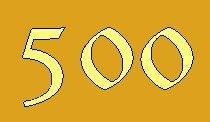
500 Rummy is one of the oldest forms of the Rummy family of games that is still widely played. From this game many of the other newer Rummy type games have been developed (such as Canasta).
The object of 500 Rummy is similar to that in most other Rummy games. This is to lay down groups or sequences of three or more cards to form point scoring melds.
This game is played with a standard deck of 52 cards. The game is usually played by between two to eight players, each playing for himself. If five or more players are playing, it is often played with two standard packs of cards which have been shuffled together to make one large deck. The rank of the cards is as follows (A,K,Q,J,10,9,8,7,6,5,4,3,2,A). The Ace (A) can be considered either high or low (being the highest card after King or the lowest card before the deuce). A sequence is not allowed to go "around the corner", in other words, an Ace can never be in the middle of a sequence (thus K,A,2,3 would not be a valid meld).

For purposes of scoring each individual card has a specific point value. Jacks, Queens and Kings count 10 points each. Numbered cards (2 through 10) are worth their numerical value. The value of an ace depends on how it is used. If the ace is part of a low sequence (i.e., A,2,3) melded to the table, it is worth one point. If it is part of a high sequence (i.e., J,Q,K,A) or part of a meld of three or more Aces, it is worth 15 points. It also has a value of 15 (negative score) when found to remain in a player's hand after another player goes out.
To determine which player is the first dealer, each player should draw a card from the face down deck. The player whom draws the lowest card is the first dealer. For purposes of this draw the ace is considered low. For the next hand, and each one thereafter until the end of the game, the deal rotates clockwise from player to player around the table.
Once the dealer is selected he then shuffles the deck and the player to the dealers immediate left cuts. The dealer starts by dealing one face-down card to each player, starting at the player to his left and continuing in a clockwise direction until each player (including himself) has seven cards. However, if there are just two players in the game, then each player should receive 13 cards. Once the initial hands are dealt, the dealer places the remainder of the deck in the center of the table face down as the stock pile. He turns over the top card of the stock pile and places it face up beside the stock pile. This is the upcard, which forms the first card of the discard pile.
Each player, starting with the player to the immediate left of the dealer then takes a turn. The turn to play rotates around the table clockwise from player to player.
On his turn, a player does several things. First, he must draw from either the stock pile or the discard pile. He can either draw the top, face down card from the stock pile or he can take any card from the face-up discard pile. The specific selected card taken from the discard pile must immediately be played to the table, to either create a new meld (see melding, below), including other cards from the player's hand or to extend an existing meld already on the table. However, a player who draws a card from the discard pile must take every card that is above it in the pile (these additional cards need not be played immediately as melds). After playing the initial card taken from the discard pile, the player can also lay down other melds with additional cards that were also taken from the discard pile (along with any from their hand).
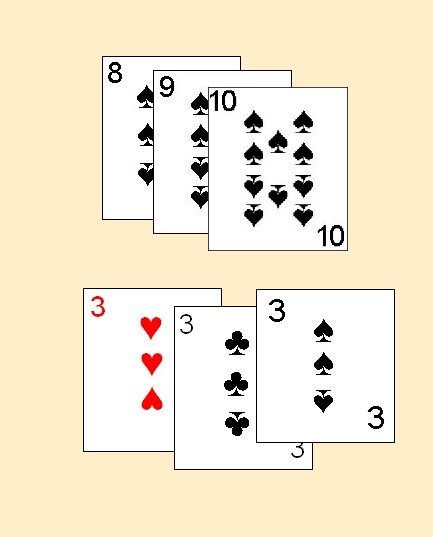 |
| The two types of melds in 500 Rum, a sequence meld and a group meld. |
Melding:
After drawing, the player is then entitled to lay down any possible melds.
There are two standard types of melds that can legally be played in this game:
-
Sequence Melds: A sequence meld is three or more consecutive cards of the same suit, such as 5, 6, 7 of clubs (♣). When an ace is used in a sequence meld it can be used as either the highest card of the sequence, coming after the King or the lowest in a sequence coming before the deuce (2). Sequence melds cannot roll over. In other words, a sequence cannot be made such as Q,K,A,2,3.
-
Groups: A group is 3 or more cards of the same rank. These cards can be of any suit, but must all be of the same rank (such as three 4's or three Jacks).
When a player has one of these two meld types in his hand, he may, at his turn play the meld face up to the table in front of himself. When a meld is played, the player who lays the meld is credited with the point value of the meld as per the card values given above. Thus, a meld of 9,10,J would score 29 points (nine points for the 9, 10 for the ten and 10 more for the Jack). All scoring occurs at the conclusion of each hand. In addition, a player on his proper turn can add one or more cards to melds that are already on the table, in effect extending the meld. He can extend either his own meld or another players. He then receives the point values for his cards played to the meld. Any number of players may extend any melds on the table such that a particular meld might have been extended by a number of players. When a player does extend another players' melds, he should lay the card on the table in front of himself such that it is obvious who to score the points for at the end of the hand. When playing such a card the player must also state which meld on the table is being extended.
The Discard:
The last part of a player's turn consists of a discard. After a player has drawn and played any melds to the table they must discard. They select one card from their hand and lay it down on the discard pile. The card must be laid down face-up on the pile, in such a way that the it does not completely cover the card immediately below it. Thus, the discard pile is somewhat spread out, with each card partially exposed from beneath the cards above it.

|
| The discards should be displayed in such a way that all cards
in the pile can be seen. A player taking a card from the discard pile must
also take all the cards above it in the pile. Thus, a player wanting to take the King would also be required to take the 10 and 5 as well.
|
Ending the Hand:
If a player plays their last cards in a meld or when discarding, discards the last card in their hand, they have gone out. At this point, the hand immediately ends and scoring for the hand takes place.
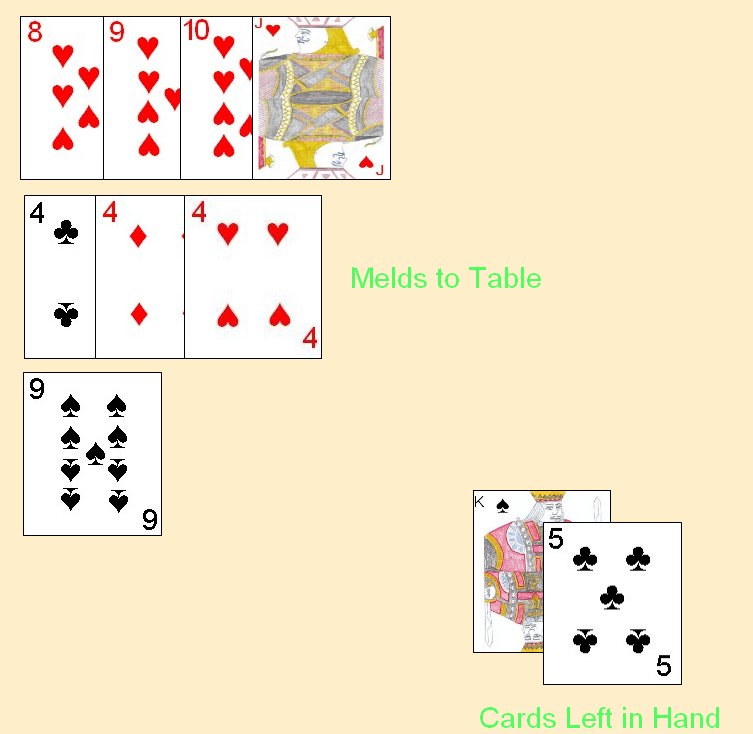 |
| In this example hand, say a player has three melds to the table. The 8, 9, 10 and Jack sequence. The three fours and the 9 of spades which was played as an extension to another meld (not shown) on the table. The player has a King and 5 still remaining in his hand. Say another player goes out. This player would score 58 for his melds to the table, minus 15 for the cards remaining in his hand. This player would score a total of 43 for the hand. |
Each player first scores the values for all the melds they have played to the table, including any cards they used to extend melds of their opponents. The scores earned for the individual cards are as per the card values previously detailed above. The point value of all unplayed cards remaining in a player's hand are then subtracted from this total. Negative scores are possible if a player has more total value in cards in his hand then he has played as melds or extensions to melds to the table during the hand. Cards that may consist of valid melds still count negative for a player if they remain in his hand and had not been played to the table during the course of the hand.
A running total of a players score is carried over from hand to hand until one player accumulates 500 or more positive points. If two or more players score 500 or more points at the end of the hand, the player with the highest total is declared the winner of the game.
The hand may also end if the stock pile runs out and a player, on his proper turn, cannot or chooses not to take cards from the discard pile. In this case the hand immediately ends and is scored. The scoring is the same as with the standard method, with each player scoring for their melded cards on the table and subtracting from that total all cards remaining in their hand.
A player would be considered to have beaten or been beaten by an opponent by the number of points difference between his score and that of each opponent.
Rummy Call: This is an optional rule that is often played when players are more experienced at the game. It is usually not used with beginning players such as not to overly punish these novice players.
If any player discards a card that could be melded to the table or leaves one or more cards at the top of the discard pile that can be melded to the table without any additional cards from a players hand, any other player may declare "Rummy"! The player calling Rummy can then take these cards and immediately make the melds as appropriate (scoring as appropriate for the addition to the meld). After making the melds, this player may then make any other melds from his hand as he would if it was his normal turn of play. He concludes his "turn out of turn" by discarding a card of his own to the discard pile. The next player, who would normally be in turn after this player then takes his turn as normal. A player declaring "Rummy" must do so before the next player draws a card (either from the discard or the draw pile). The player who just finished their turn may not call Rummy on their own discard. Rummy may never be called once a player plays his last card, even if his last discard is one that could be played to a meld on the table.
Optional Top Discard Rule: This variation is played identically to the standard game with one difference in regards to the discard pile. In this version, a player may take the topmost card of the discard pile even if he chooses not to (or cannot) use the card in an immediate meld. If he takes any but the top card of the discard pile, the standard rules apply in which he must use the bottom most card in an immediate meld.
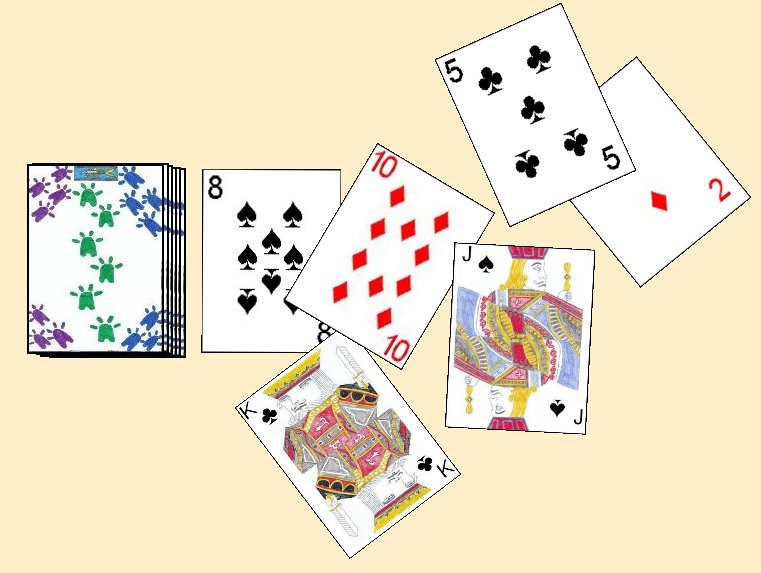 |
| In Thrown Down 500 Rum, the discard pile can be a total disarray, which is all part of the fun. |
500 Throw Down Rum: 500 Throw Down Rummy is a variation of 500 Rum which can be great fun for almost any number of players. The rules are identical to Standard Rummy with a few changes based on the handling of drawing and the discard pile. When a player discards at the end of his turn, instead of neatly arranging his card on the discard pile, the player simply tosses his card toward the other discards. In this way, the discard "pile" ends up being a scattered array of cards on the table. If the tossed card flies off the playing surface, ends up flipping to be face down or otherwise ends up in an inappropriate location, it should be righted and placed somewhere in the discard area. As there is no obvious order to this discard "pile", when drawing a discard, a player can take any discarded card in the discard area. If taking a card from the discard area, the player must also take any other discards that happen to be on top of the selected card (even if the upper card is only slightly covering the wanted card). As in most other versions of 500 Rum, the player can also take the top of the stock pile. A player may only take one card on his turn (either any discard or the top of the stock pile), and he may take a card that might be somewhat buried under other discards. During his, however, other cards should only be moved, however, to get another discard that may be partially covered by that card. In other respects this version is played identically to 500 Rum.
Discards Displayed on Table: This is not so much a variation as a mechanism to help players remember previously drawn cards. When a player takes cards from the discard pile, he must leave the taken cards that are not melded on this turn, face up in front of himself until his next turn. This allows the other players a longer opportunity to attempt to memorize these cards taken.
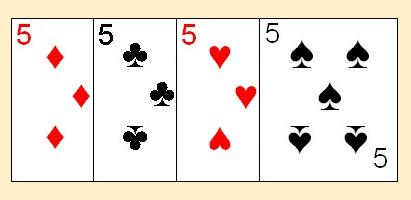 |
| Melding four cards of the same rank in Persian Rummy all at the same time scores double for that meld. This meld, for example would score a total of 40 points. |
Persian Rummy: Persian Rummy is a variation of 500 Rummy that is played by four players in two partnerships.
If not already predetermined in some manner, the partnerships should be determined by each player drawing one card from a face-down, shuffled deck. The players drawing the two highest cards play as partners against the players drawing the two lowest. Also, the player drawing the lowest card is the first dealer. The partners should each sit opposite each other at the table such that the turns will rotate with an intervening player between the partners turns.
Persian Rummy uses the standard 52 card deck with the addition of four jokers. These Jokers are not considered wild cards in this game, and instead are cards that can be melded in their own separate group. They cannot be melded in any sequence group. For purposes of scoring jokers are worth 20 points. When drawing for partners and dealer, a player drawing a joker should draw again.
In Persian Rummy, the ace is considered high, and thus can only be melded in high sequence melds (i.e. K,Q,A
etc.) or in a group of three or four aces. Aces are always worth 15 points.
If a player melds, all at the same time, a group of exactly four cards of the same rank, it counts double. If a player adds a fourth card to an existing group of three the meld counts as standard.
All scores for both players in a partnership are combined together, positive and negative. When a player goes out (melds or discards the last card in his hand) his partnership scores a bonus of 25 points in addition to the value of the meld.
When the stock pile is exhausted, the game continues as long as each player, in their turn, legally can and wants to draw from the discard pile. In this situation, as soon as a player does not draw from the discard pile on their turn, the game immediately ends and the counts of all the cards remaining in their hands are subtracted from their partnerships score.
When a side reaches 500 points at the completion of a hand, that side is considered the winner of the game and receives a bonus of 50 points. If, at the end of a hand both partnerships have reached 500 or more points, the partnership with the higher score is considered the winner, receiving the 50 point bonus for winning the game.
Oklahoma: Oklahoma or Oklahoma Rummy is another fun 500 Rum variant designed for 2 to 4 players. This game is also often called Arlington. It is not the same game as Oklahoma Gin which is a variant of Gin Rummy. Oklahoma Rummy is played with two standard
52 card decks shuffled together.
In this game all deuces are considered wild cards and thus can be substituted for any other card in a valid meld.
The basic rules of Oklahoma are the same as in 500 Rum with a few key changes that make this game uniquely different as well.
Each player draws from the face down deck with the player drawing the lowest card becoming the first dealer. The game is dealt and played in a clockwise direction. The dealer begins by distributing cards one at a time face down to each player until all players have 13 such cards. He then places the deck face down in the center of the table and takes the top card of the stock pile and lays it beside the stock to begin the discard pile. Each player, starting with the player to the dealers immediate left is given the opportunity to take that discard. If any player takes this discard, they then begin the game, becoming the first player. This player then takes his turn as normal, melding (if able and willing) and discarding as normal. After this, each turn consists in the normal manner (with players taking the top of stock pile or the discard pile, melding and then discarding). If no player takes that first discard, the player to the dealers immediate left draws the top of the stock pile and play begins as normal.
Whenever a deuce is played, the player of the deuce must state what specific card it represents if there is any doubt. Once played a wild card deuce may never be substituted for the actual natural card it replaces by any player. Players may only lay off cards to their own previous melds and may never add additional cards to a group that already contains four cards of the same rank.
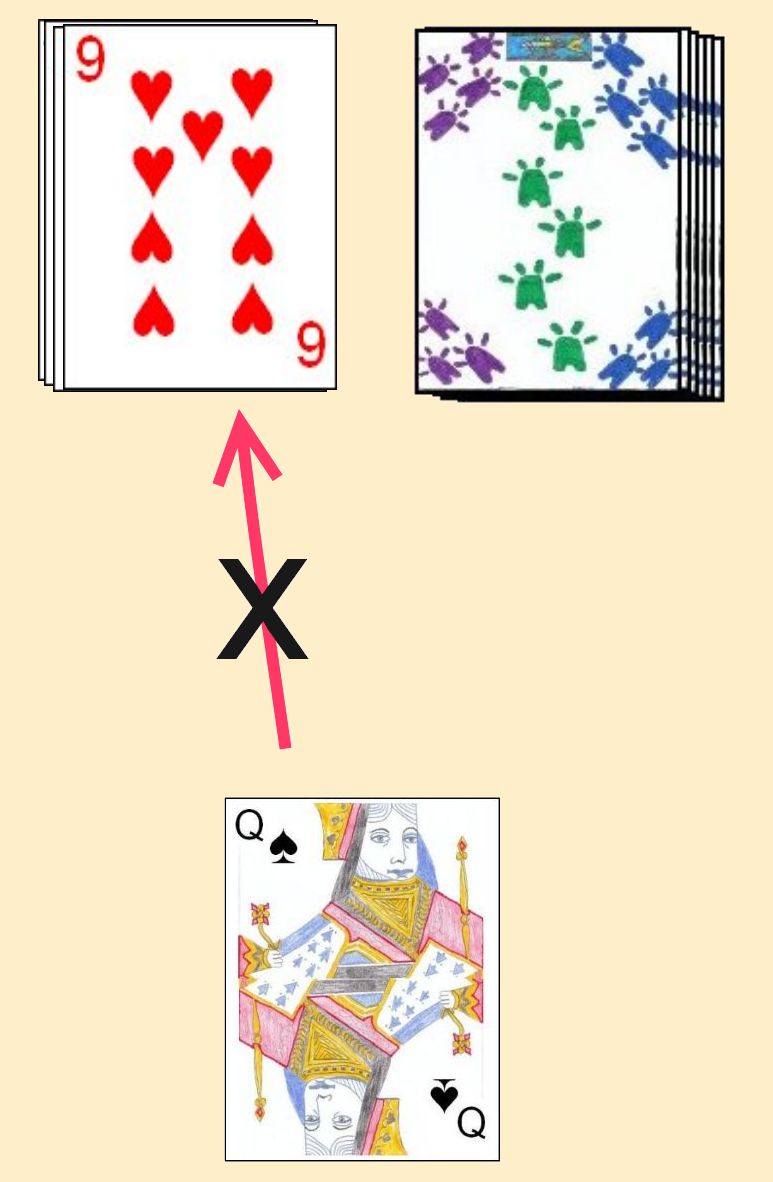 |
| In Oklahoma Rummy, the Queen of Spades may never be discarded unless it is a players last discard in his hand. |
Another major difference between Oklahoma and 500 Rum is in the taking of cards from the discard pile. If a player, on his turn takes the top card of the discard pile, he must take the entire discard pile, adding it to his hand. He must immediately use the top card from the discard pile in a new meld or add it to one of the melds he already has on the table. On his turn, a player may make new, legal melds or add to his own melds, but never to those of other players. Aces can be considered the highest card of any suit or the lowest, thus they can be played as the last card after a King or as the first before a natural deuce not being used as a wild card.
Another challenging and exciting feature of this game is that a player who holds in his hand the Queen of Spades (♠) may only be rid of it in two circumstances. He may either play it in a legal meld or discard it as his last card when going out. When going out, a player must always discard, they may never meld their last card. The hand immediately ends and is scored as soon as any player discards this last card. The game will also immediately end in the event that the player to take the last card of the stock pile does not go out (called a block). When either of these events occurs, each player adds the total value of all cards in their own melds and subtracts the values of all cards still remaining in their hand. A player going out earns an immediate bonus of 100 points unless he goes out by melding his entire hand without having melded any cards prior in the hand. In that case he earns a 250 point bonus instead. This 250 point bonus, however, is not counted for determining if the player exceeds the 1000 points required to win the game. The scoring values for the cards, both left in the hand and melded are shown in the following table:
| Card | Value in Meld | Value found in Hand |
|---|
| Ace | 20 | -20 |
| King, Jack, 10, 9, 8 | 10 | -10 |
| Queen of (♦), (♥), (♣) | 10 | -10 |
| Queen of Spades (♠) | 50 | -100 |
| 7, 6, 5, 4, 3 | 5 | -5 |
| 2 | Value of Card Represented | -20 |
Note: If a 2 is used as an actual, natural 2, it's value is 5 points. If a 2 is used to replace the Queen of Spades its value is set at 10 points.
If, at the end of any hand, any players score is equal to or exceeds 1000 points, he is instantly declared the winner of the game. However, if multiple players reach or exceeds 1000 points at the end of any hand, the player with the highest score is set as the winner. The winner of the game receives an additional bonus of 200 points.
Oklahoma With Jokers: This version of Oklahoma is played identically to standard Oklahoma with one difference. From one to four Jokers are added to the double pack used. A Joker is similar to a deuce in that it can be substituted for any other card in a valid meld. Unlike a deuce, however, the player who played the Joker may take the Joker back into his hand and replace it with the natural card for which it was replacing. For scoring purposes a Joker adds 100 points when part of a valid meld but costs a player 200 points when found remaining in his hand at the end of the hand. When drawing for first dealer, the Joker is considered lowest card. A player, on his turn may also take the top card of the discard pile (and thence the entire pile) to replace the natural card for a Joker in one of his own melds.
Michigan Rummy: Michigan Rummy is another Rummy game which closely follows the rules of 500 Rummy. This game should not be confused with the game "Michigan" another fun game which is a member of the Stops family.
Michigan Rummy is played identically to standard 500 Rum with a few key differences, primarily in regards to the scoring. In this version a running score is kept for each player during the hand, and the player scores as he makes his melds. At the end of the hand, when one player goes out (called going Michigan), the other players then subtract the value of the cards remaining in their hands from their current score. Negative scores are possible. Each hand is considered a complete game, so scores from one game are not carried over to the next.
In Michigan Rummy if a player discards a card that can be laid off on any meld on the table, the first player to shout "Stop" can temporarily pre-empt the current turn. He takes the card, adds it to the appropriate meld and may discard any card of his choice from his own hand. The turn then returns to the next player after the original discarding player.
5000 Rummy: 5000 Rummy is a unique variant of 500 Rummy. It is played similarly to 500 Rum, however it has several differences that make the gameplay markedly different.
The game is sometimes known as Hillbilly Rummy, Dummy Rummy or Wild One. The following list details the differences between this game and standard 500 Rummy:
- As the name of this game implies, the target score to win in this game is a cumulative score of 5000 or more points. Once any player reaches 5000 or more points the game ends, with the player with the highest total declared the game winner.
- The first card dealt to each player on each hand is dealt face up. This card then determines the total number of additional cards initially dealt to that player. The player thus immediately receives a number of additional cards, dealt face-down, to his hand based on the rank of his first exposed rank card. The following chart shows these corresponding numbers of additional cards a player would be dealt dependent on his first face-up card dealt:
| Initial Card Dealt | Additional Cards Dealt to That Player |
|---|
| 2 | 2 |
| 3 | 3 |
| 4 | 4 |
| 5 | 5 |
| 6 | 6 |
| 7 | 7 |
| 8 | 8 |
| 9 | 9 |
| 10, Jack, Queen, King | 10 |
| Ace | 11 |
|
|
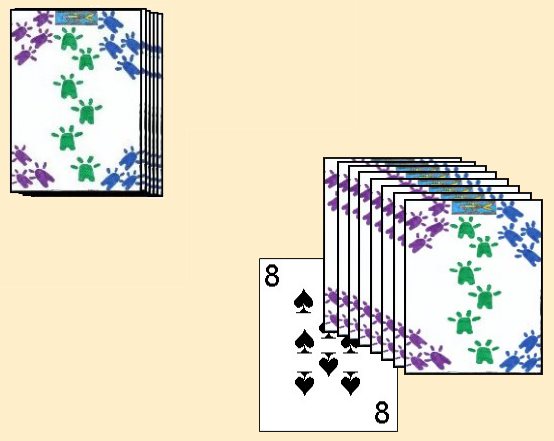
|
These additional cards are dealt immediately after the first face-up card is dealt. Once that player has his required number of cards, the dealer then repeats this process to the next player in a clockwise direction. He continues this procedure around the table up to, and including himself.
- For the dealer, in addition to determining the number of additional cards he will receive, this card and all other cards of the exact same rank are considered wild cards for the hand. A wild card can be used as a replacement for any other card in a meld.
- If a player has the natural card in his hand for a wild card currently used in a meld on the table (his own or anyone
else's) he may simply play the natural card in front of himself. The wild card still remains in it's previous place in it's existing meld, not taken up by the player who played the natural card corresponding to the wild card.
- For scoring purposes, melded cards are worth a certain number of points as per the following chart:
| Melded Card | Point Value |
|---|
| 2, 3, 4, 5, 6, 7, 8, 9 (non wild) | 5 points each |
| 10, Jack, Queen, King (non wild) | 10 points each |
| Ace (non wild) | 100 |
| Ace (wild) | 200 |
| All Other Wild Cards | 100 |
- If a player manages to meld all his cards (minus the one required discard) he scores points (based on the scoring table above) for each card left remaining in the other player's hands.
- In order to win the hand, a player must meld all cards in his hand save one, which he must discard. If a player is able to meld all his cards but has no discard, play continues with the player who melded all his card said to "float", continuing play with no cards in hand. On each subsequent turn he must draw a card from the draw pile. If this card can legally be played to an existing meld on the table he must do so, and again is said to float. However, if the card cannot be legally played to any meld, he may discard the card to the discard pile and ends the hand.
- If a player notices that another player discards a card which can legally be played to an existing meld on the table, he may call Rummy, even if not his turn. In order to call Rummy, however, the player must have at least made one legal meld to the table. The player who first calls Rummy may then immediately take the discarded card and play it as appropriate. The turn then reverts to the player who was next after the player who discarded the card on which Rummy was called.
- If the draw pile is depleted before any player manages to meld all his cards and discard, the hand ends and the players score for the melds they have made during the hand, as normal. However, no players score for cards remaining in other peoples hands for this hand.
In all other respects this game is played identically to 500 Rum.
Banakil: Banakil is a
Rummy type game which plays somewhat similar to 500 Rum and is popular in Jordan, Libya and much of the surrounding area. It can be played by 2 or 3 players. If 4 players participate, it is usually played as a partnership game (see the rules for Partnership Banakil, described further below).
Banakil is played with a deck of 106 total cards. This deck can be created by combining two standard 52 card decks together and then adding two total Jokers to the mix. All Jokers and twos are considered wild cards and can be used to substitute for any other card in the deck in a sequence meld. The ranking of the remaining cards (for the purposes of sequences) is as follows, shown from highest to lowest; Ace, King, Queen, 10, 9, 8, 7, 6, 5, 4, 3.
Determination of seating positions and first dealer can be performed using a variety of methods, with draw for high cards a common method. Using this method, each player draws a card from the shuffled deck, and each player seats himself at the table in order of rank of cards drawn, from highest to lowest. If two or more players draw equally ranked cards, they should draw a new card from the deck. If the player again draws a card equal to one already previously drawn by another player, they should again draw another card from the deck, continuing to so draw until drawing a card of a rank not previously drawn by any other player. The player drawing the highest card of all is set as the first dealer. After each hand the role of dealer rotates around the table in a counter-clockwise direction around the table.
Once the players are seated and the first dealer selected, this player should again thoroughly shuffle the cards and offer it to the player at his immediate left to cut. After the cut the dealer then begins distributing the cards around the table, starting with the player at his immediate right and continuing in a counter-clockwise direction. He deals the cards in small batches of two cards at a time, with each packet dealt face down in front of each player, continuing around the table until each player has a total of 18 cards. The dealer then places the remainder of the deck in a face-down pile near the center of the table and turns over the top card from the stock, placing it face-up beside the stock pile to start the discard pile. The player to the immediate right of the dealer has the first turn, and play rotates around the table in a counter-clockwise direction.
Each player's turn begins with a draw. A player may either draw the top, face-down card from the stock pile or may draw one or more cards from the discard pile. However, if the player elects to take any card from the discard pile, he must take all cards above it in the discard pile as well.
After the draw, the player then has the option to make one or more melds, if willing and able. In Banakil, there are two types of melds which a player can make on his turn:
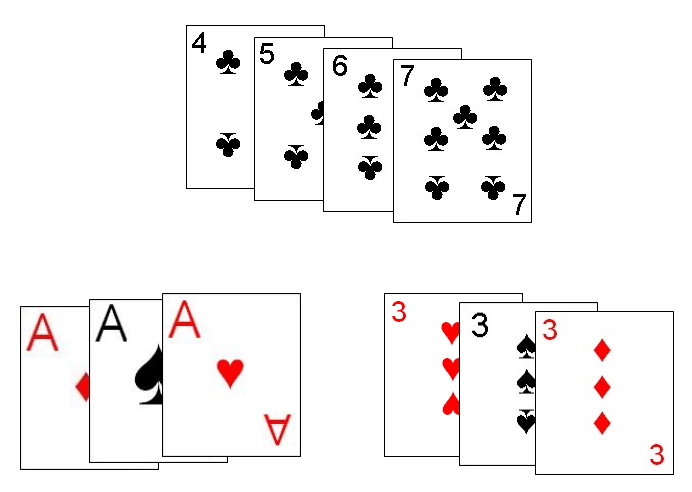 |
| Examples of a Siri meld and the only two Majmoo'a meldable ranks allowed in Banakil. |
- Sequence (Siri):
A sequence meld is three or more cards in direct sequential order, all of the same suit (for example the eight, nine, and ten of spades). The highest card allowed in any sequence is an Ace and the lowest allowable card in a sequence meld is three. A player's melds should be played face-up on the table in an area in front of the player, and the cards should be arranged in the meld in ascending order from left to right from the perspective of the player making the meld. As mentioned previously, twos and Jokers are considered wild cards and can be used to substitute for any other card in a sequence meld. However, any specific sequence meld may contain a maximum of one Joker and a maximum of one two. Normally, the maximum length of a sequence meld, in number of cards, is 12, however, if the meld contains a two, and the natural card replacement for the two is added to the meld, the two can then be moved to the end of the meld creating a 13 card meld.
- Group (Majmoo'a): There are only two allowable group melds in the game of Banakil:
- Aces:
This is a meld of three or four Aces, all of different suits.
- Threes:
This is a meld consisting of three or four threes, all of different suits.
A group meld may contain, at a maximum one Joker but may never contain any twos. If a player makes such a meld containing a Joker and later finds that he can replace the Joker with another natural card (and the meld is still valid) the player may thus play that card in place of the Joker and take the Joker back into his hand for use with another meld.
In addition to creating new melds, a player may also add cards to existing melds that this same player has already played to the table. If the player has created a meld on the table which contains a Joker, and he later finds he has the card for which the Joker is replacing, that player may play that card in place of the Joker, and
thus taking the Joker back into his hand for use with another meld as needed. Similarly, if a player's previous meld contains a two, and the player later finds the card the two is replacing in his hand, he may play that card. However in the case of a two he may not take the two back into his hand but may move it another location in the same sequence meld, replacing another missing card at one end of the sequence meld.
To complete his turn, a player then discards one card from his hand to the discard pile. Each card discarded to the discard pile should be played in such a manner that it slightly overlaps the previous card to allow all the cards in the discard pile to be in view of all players. Although not strictly required, it is customary in polite card games for a player to make an announcement when he has reduced his hand, after his discard to two or fewer cards.
If a player manages to meld all the cards remaining in his hand during his play, or manages to meld all but one card and then discards that last card, the hand immediately ends and scoring for the hand is calculated. The following are all the possible scores and penalties that can be earned in the game:
- The player who manages to end the hand by depleting all cards in his hand earns 20 points.
- If a player has not managed to meld any cards during the current that player must subtract 20 points from his current score, however that player is not required to subtract additional points from his score for unmelded cards still remaining in his hand (see below).
- A player earns a number of points based on all cards that player managed to meld during the hand. The value of the different cards which might comprise the meld are as follows:
| Card | Scoring Value |
|---|
| Joker | 4 Points Each |
| 2 | 2 Points Each |
| Ace | 1 1/2 Points Each |
| 7, 8, 9, 10, Jack, Queen, King | 1 Point Each |
| 3, 4, 5, 6 | 1/2 Point Each |
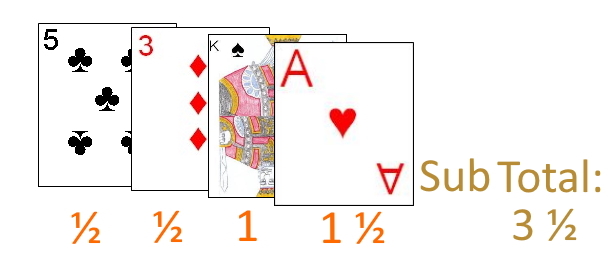 |
| As an example, a player finding these cards in his hand after another player goes out would have a sub-total of negative 3 1/2 points for cards remaining in his hand. |
- A player must subtract from his score a number of points based on the cards still remaining in the hand. The same card values as used for melded cards is thus used to determine these point values.
- If a player manages to meld his entire hand in one turn, without previously having melded any cards, that player earns a total of 40 points (called Hand). However, in this event the player does not score any points for individual melded cards.
After all a player's points for the hand have been totaled (positive and negative) any fractional points are thus rounded upwards. Thus, any remaining positive half points are rounded up to the next whole number and any negative half points are simply truncated. Players keep an ongoing cumulative score from hand to hand, and negative scores are possible.
In addition to the hand ending by a player fully depleting his hand of cards, the hand can also end if the stock pile runs out of cards, and after the player who draws that last card finishes his play and discard, every player has at least one card still remaining in the hand, the hand immediately ends and no scoring occurs for that hand.
The game continues in this manner over a series of hands until one or more players, at the end of a hand reaches a predetermined scoring threshold. If two players are participating, this threshold is usually set at 150 points and if three are playing this is set at 203 points. Once one or more players, at the end of any hand reach or exceed this total, all the scores are compared and the player with the highest cumulative total is declared the game winner.
Partnership Banakil: As mentioned above, Banakil can also be played by four participants. When played by four players, these players are thus divided into two partnerships of two players each. The game is played identically to standard Banakil, with the following differences:
- If partnerships have not been predetermined, the players can use any random method to select partnerships, such as drawing from the shuffled deck, with the players drawing the two highest cards playing as partners against the players drawing the two lowest. Each player should sit directly across the table from his partner.
- On a player's turn, he may not only add cards to melds he himself has made, but may also add cards to melds made by his partner. These cards would be added directly to the meld to be added to. However, before being able to add such cards, the player must have already made at least one personal meld of his own.
- Similarly to adding melds to the partner's melds, a player may also take a Joker from an existing meld of himself or his partner, replacing the Joker with the natural card it was representing. However, before doing this, the player must have played at least one full meld of his own to the table on this hand.
- A player is not entitled to collect the 40 point Hand bonus unless he manages to make this meld before any other player has melded a single card to the table. If another player has already so melded, the player does not get the 40 point bonus, but does still get the 20 point bonus for being the first player to play all his cards and any points earned for cards he has melded.
- At the end of the hand, the team containing the player who managed to first deplete his hand earns an accumulating score equal to the number of points earned by the winning player. The opponent team earns a score equal to the total of both of those opponents scores added together and subtracting the total score from the partner of the winning player.
- The game continues over a number of hands until one or both partnerships earns an accumulated score of 303 points or more, with the partnership with the higher total score declared the winner of the game.
In all other aspects Partnership Banakil is played identically to the 2 and 3 player version
of Banakil as described higher above.
Thai Rummy: Thai Rummy is a game which is played somewhat similarly to 500 Rum, and is commonly played in Thailand. The game is also commonly played under the name "Dummy".
Thai Rummy is played by 2, 3, 4 or 5 players all playing independently. The number of decks used is directly dependent on the current number of players. For two or three players, the game should be played using one standard 52 card deck. For three or four participants, it would normally be played using two such standard 52 card decks shuffled together to form a large deck consisting of 104
total cards. The relative ranking of the cards in the deck, for consideration in run melds, is as follows (from highest to lowest): Ace, King, Queen, Jack, 10, 9, 8, 7, 6, 5, 4, 3, 2.
Determination of seating positions and first dealer can be performed using any method, such as draw for high cards. Once this has been determined the dealer should then thoroughly shuffle the deck and offer it to the player at his right to cut. After the cut, he then begins dealing the cards around the table, starting with the player at his immediate left. He deals the cards one-at-a-time and face-down around the table in a clockwise direction until each player has a total of 13 cards. He then places the remainder of the cards in the middle of the table as the stock, and turns up the top card from the stock, laying it face-up beside the stock to form the draw pile. This first card of the discard pile is called the head card. The player to the immediate left of the dealer has the first turn, and the turns rotate in a clockwise direction around the table.
The object of this game, as in most other forms of Rummy, is to be the first to deplete his hand by forming it into a number of various melds. Towards this aim, each turn consists of multiple actions:
- Draw:
To start his turn, a player begins by drawing a card. A player may elect to draw from the stock or from the discard pile. If he elects to draw from the stock he simply adds the top face-down card from the stock into his hand.
Alternatively, the player may instead take one or more cards from the discard pile. If taking any card from the discard pile, he must also take all cards found stacked above that card in the pile. He must also be able to use the bottom card drawn as part of this stock in a valid meld that he immediately plays to the center of the table.
- Optional Meld:
A player may, on his turn make any number of legal melds to the center of the table. There are two types of melds in Thai Rummy. The first type is a set meld which is three or more cards all of the same rank (such as 4 fives or 3 Queens).
The second type of meld recognized in this game is the series meld. A series meld is three or more cards in direct sequential
ranking, all of the same suit. A player may also lay-off legal cards to extend other player's (or those made by himself) melds already found on the table. If laying off on existing melds, however, the actual card should be place on the table in front of the player playing it, to aid in scoring at the end of the hand. A player may never meld his last card, and must retain a least one card (which they may discard).
- Discard:
To conclude his turn, a player must then discard one from the hand. This can be any unused card within the hand. The cards are discarded face-up on the discard pile, but should be place in such a way that the
previous cards are all partially visible to all players. After a player discards on his turn, the turn ends and the next player in a clockwise direction has their turn. If a player has melded all but one card, and discards that last card the hand immediately ends (this is called a knock). If the stock pile is empty, and the player cannot (or prefers not) to draw from the discard pile, he must pass.
The hand can end in two ways. If a player discards the last card from his hand, the hand immediately ends. Alternatively, if the discard pile is exhausted and all players consecutively pass, the hand also ends immediately.
After the hand ends, scoring of the hand begins. There are a number of scoring
opportunities (as well as penalties) that can be scored or incurred during the hand:
- A player who manages to discard his last card, ending the hand, scores 50 points towards his ongoing score.
- A player earns a point value based on every card he managed to meld during his turns. The following chart shows the point value for each card in the deck:
| Card | Scoring Value |
|---|
| 2 (except 2 of clubs), 3, 4, 5, 6, 7, 8, 9 | 5 Points Each |
| 10, Jack, Queen (except Queen of spades), King | 10 Points Each |
| Ace | 15 Points Each |
| 2 of clubs (♣), Queen of spades (♠) - Called Spetro Cards | 50
Points Each |
|
|
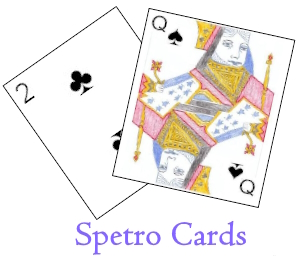
|
- Similarly, a player must subtract a like number of points for each card that he still has remaining in his hand, even if those cards could be formed into legal melds
or be laid off to existing melds on the table.
- If a player discards a card to the discard pile which allows the immediately next player to deplete his hand, the player making that discard must subtract 50 points from his current ongoing score.
- If a player discards a card to the discard pile which the next player can immediately pick up and play to an existing meld on the table, the player discarding such a card must also subtract 50 points from his current score.
- If a player melds his entire hand (except one card which he must discard) on the same turn (never having previously melded on prior turns) all scores for that player are doubled on that hand (both positive and negative).
- If another player manages to meld all his cards on the same turn, and another player has not made any melds yet to the table, all scoring for that other player are also doubled (both positive and negative) from that hand.
If a player is initially dealt both Spetro Cards (2 of clubs and the Queen of spades), he may show these cards on his first turn, and is entitled to an immediate bonus of 400 points. However, if another player manages to "knock" winning the hand before that player has his first turn, he must subtract 800 points from his current ongoing score instead.
At the end of each hand, after accumulated scores are totaled, the cards are gathered, shuffled and dealt by the next dealer in turn (the player to the immediate left of the previous dealer). If, at the end of a hand, any player is found to have reached -500 or a lower score, the game immediately ends with the player having the highest current score declared the winner. Similarly, reaching a score of 500 is partial criteria for winning the game. However, simply having 500 or more points is not enough to win. The player must also win the hand (be the first to deplete his cards form his hand)
with his score at 500 or higher, in order to be declared the winner of the game.
Copyright © 2015 CatsAtCards.com. All rights reserved.
 500 Rummy is one of the oldest forms of the Rummy family of games that is still widely played. From this game many of the other newer Rummy type games have been developed (such as Canasta).
500 Rummy is one of the oldest forms of the Rummy family of games that is still widely played. From this game many of the other newer Rummy type games have been developed (such as Canasta).










